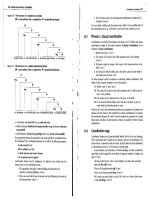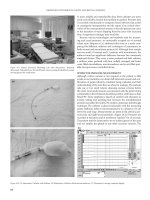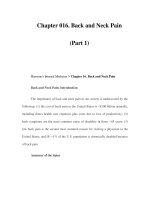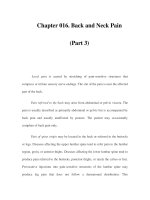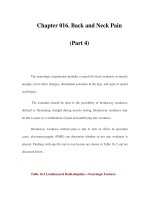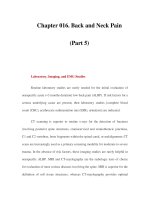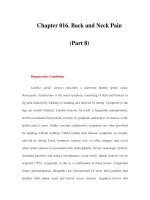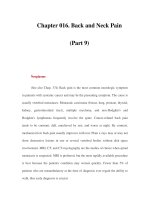Chapter 073. Enteral and Parenteral Nutrition (Part 11) ppsx
Bạn đang xem bản rút gọn của tài liệu. Xem và tải ngay bản đầy đủ của tài liệu tại đây (20.27 KB, 6 trang )
Chapter 073. Enteral and
Parenteral Nutrition
(Part 11)
Infectious
Infections of the central access catheter rarely occur in the first 72 h. Fever
during this period is usually from infection elsewhere or another cause. Fever that
develops during PN can be addressed by checking the catheter site and, if the site
looks clean, exchanging the catheter over a wire with cultures taken through the
catheter and at the catheter tip. If these cultures are negative, as they are most of
the time, the new catheter can continue to be used. If a culture is positive for a
relatively nonpathogenic bacteria like Staphylococcus epidermidis, consider a
second exchange over a wire with repeat cultures or replace the catheter depending
on the clinical circumstances. If cultures are positive for more pathogenic bacteria,
or for fungi like Candida albicans, it is generally best to replace the catheter at a
new site. Whether antibiotic treatment is required is a clinical decision, but C.
albicans grown from the blood culture in a patient receiving PN should always be
treated because the consequences of failure to treat can be dire.
Catheter infections can be minimized by dedicating the feeding catheter to
PN, without blood sampling or medication administration. Central catheter
infections are a serious complication with an attributed mortality of 12–25%.
Infections in central venous catheters dedicated to feeding should occur less
frequently than 3 per 1000 catheter-days. Home PN catheters that become infected
may be treated through the catheter without removal of the catheter, particularly if
the offending organism is S. epidermidis. Clearing of the biofilm and fibrin sheath
by local treatment of the catheter with indwelling alteplase may increase the
likelihood of eradication. Antibiotic lock therapy with high concentrations of
antibiotic, with or without heparin in addition to systemic therapy, may improve
efficacy. Sepsis with hypotension should precipitate catheter removal in either the
temporary or permanent PN setting.
Enteral Nutrition
Tube Placement and Patient Monitoring
The types of enteral feeding tubes, methods of insertion, their clinical uses,
and potential complications are outlined in Table 73-9. The different types of
enteral formulas are listed in Table 73-10. Patients receiving EN are at risk for
many of the same metabolic complications as those who receive PN and should be
monitored in the same manner. EN can be a source of similar problems, but not to
the same degree, because the insulin response to EN is about half of that seen with
PN. Enteral feeding formulas have fixed electrolyte compositions that are
generally modest in sodium and somewhat higher in potassium content. Acid-base
disturbances can be addressed to a more limited extent with EN. Acetate salts can
be added to the formula to treat chronic metabolic acidosis. Calcium chloride can
be added to treat mild chronic metabolic alkalosis. Medications and other additives
to enteral feeding formulas can clog the tubes (e.g., calcium chloride may interact
with casein-based formulas to produce insoluble calcium caseinate products) and
may reduce the efficacy of some drugs (e.g., phenytoin). Since small-bore tubes
are easily displaced, tube position should be checked at intervals by aspirating and
measuring the pH of the gut fluid (<4 in the stomach, >6 in the jejunum).
Table 73-9 Enteral Feeding Tubes
Type/Insertion
Technique
Clinical Uses Potential
Complications
NASOGASTRIC TUBE
External measurement:
Short-term Aspiration;
nostril, ear, xiphisternum; tube
stiffened by ice water or
styl
et; position verified by
injecting air and auscultating,
or by x-ray
clinical situation
(weeks) or longer
periods with
intermittent insertion;
bolus feeding simpler,
but continuous drip
with pump better
tolerated
ulceration of nasal
and
esophageal tissues,
leading to stricture
NASODUODENAL TUBE
External measurement:
nostril, ear, anterior superior
iliac spine; tube stiffened by
stylet and passed through
pylorus under fluoroscopy or
with endoscopic loop
Short-term
clinical situations
where gastric emptying
impaired or proximal
leak suspected; requires
continuous drip with
pump
Spontaneous
pulling back into stomach
(position verified by
aspirating content, pH >
6); diarrhea common,
fiber-
containing formulas
may help
GASTROSTOMY TUBE
Percutaneous
placement endoscopically,
radiologically, or surgically;
after tract established, can be
converted to a gastric "button"
Long-term
clinical situations,
swallowing disorders,
or impaired small-
bowel absorption
requiring continuous
drip
Aspiration;
irritation around tube exit
site; peritoneal leak;
balloon migration and
obstruction of pylorus
JEJUNOSTOMY TUBE
Percutaneous
placement endoscopically or
radiologically via pylorus or
endoscopically or surgically
directly into the jejunum
Long-term
c
linical situations
where gastric emptying
impaired; requires
continuous drip with
pump; direct
endoscopic placement
(PEJ) is the most
comfortable for patient
Clogging or
displacement of tube;
jejunal fistula if large
-
bore
tube used; diarrhea from
dumping;
irritation of
surgical anchoring suture
COMBINED GASTROJEJUNOSTOMY TUBE
Percutaneous
placement endoscopically,
radiologically, or surgically;
intragastric arm for continuous
or intermittent gastric suction;
jejunal arm for enteral feeding
Used for patien
ts
with impaired gastric
emptying and at high
risk for aspiration or
patients with acute
pancreatitis or proximal
leaks
Clogging:
especially of small bore
jejunal tube
Note:
All small tubes are at risk for clogging, especially if used for crushed
medications. In long-
term enteral patients, gastrostomy and jejunostomy tubes can
be exchanged for a low-profile "button" once the tract is established.
Source: Adapted from chapter in
Harrison's Principles of Internal
Medicine,
16e, by Lyn Howard, MD.
